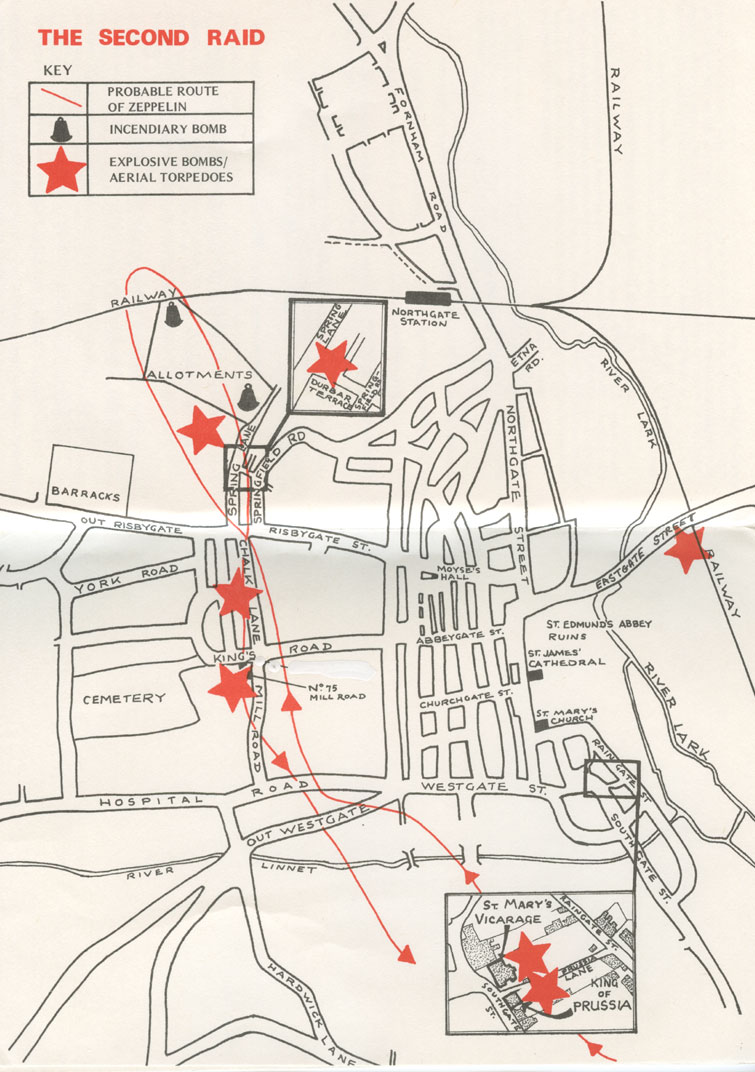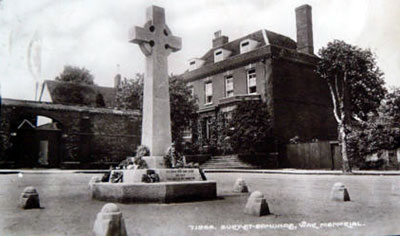
The Defence of the Realm Act (DORA) 1914, was a wide ranging act, giving the government power over censorship, imprisonment without trial and the commandeering of economic resources. It also dealt with civilian behaviour such as the consumption of alcohol and the blackout regulations. This poster was issued by Arthur Wheeler, the Town Clerk of Bury St Edmunds, on September 14th, 1915, to emphasise the importance of reducing light output at night. Despite these precautions the Zeppelins would return to Bury in March 1916. More of the poster can be seen by clicking on the picture above.
|

This map by Chris Mycock of St Edmundsbury Museum Service, shows the route which the Zeppelin probably took in its attack on Bury on 31st March, 1916. This was part of the Great Zeppelin Raid of the night of 31st March / 1st April 1916. Zeppelin L16, under Captain Werner Peterson, dropped many of his bombs on Bury St Edmunds.
|

A year after the first air raid, air power returned to Bury St Edmunds when a Zeppelin airship appeared overhead around midnight on Friday 31st March, 1916, and bombed the town. This time seven people were killed and several premises destroyed. Mill Road and Chalk Road houses were hit, possibly in an attempt to attack the old barracks in Kings Road, or the engineering works of Robert Boby. The picture shows numbers 74 and 75 Mill Road, where 4 people died. Mr Harry Frost died in number 74 and next door, Mrs Dureall and two of her children died.
On the night of 31st March/1st April, seven Zeppelins had set out to attack England. A log extract for Zeppelin L16 for April 1916 says, " Came in at Winterton and made for Bury St Edmunds at midnight. Dropped bombs. Made for Lowestoft and home."
(Another notable action from this attack was the L22 which bombed Cleethorpes, killing 31 soldiers of the 3rd battalion, the Manchester Regiment.) (Source - 'Zeppelins over the Eastern Counties' by Cliff Clover.)
|

A report published in the Bury Free Press on April 8th, 1916, says the bombs hit a certain ancient and well known town but does not name it or the victims for security, following the tightening up of the D-Notice system. The Germans knew very well where they had attacked, as the log of Zeppelin L16 records they knew they had hit Bury St Edmunds.This picture shows the Dureall family of 75 Mill Road, with labels attached to show their injuries and their fate. Ironically the father, Thomas Dureall, survived the war despite being in the Suffolk Regiment's 2nd battalion since 1911. He would accompany them to France in December 1916, and he served there until 1919, eventually reaching the old age of 78.
|

The air raid in March, 1916 was more destructive to domestic property and lives than the Zeppelin attack in 1915. This is Springfield Road after the 1916 Zeppelin raid on Bury St Edmunds, Suffolk. The photograph was taken from a window giving a view of buildings destroyed by the raid.
|

Probably also showing damage at Springfield Road after the 1916 Zeppelin raid on Bury St Edmunds, Suffolk.
|

Probably another view of the damage at Springfield Road after the 1916 Zeppelin raid.
|

This picture is another view of the damage at Springfield Road after the 1916 Zeppelin raid. This has been confirmed by Mrs Barbara Clements who tells me that she recognises her mother, Lilian May Herrington, aged 16 or 17 at the time, wearing the hat. She is with her little brother, Bertram.
Mr Bill Fenner has another copy of this postcard which is annotated on the back as follows: "Mr Gross' house in the distance side of summerhouse look as if attached to it. You can see the boys on top of wreckage looking into stable at the Dead Horse. This view was taken from top of Mr Cox's stable wreckage."
|

This picture of the 1916 Zeppelin raid on Bury St Edmunds, Suffolk, is also from the Spring Lane area. It was published by Drew's Imperial Studios of 26 Cornhill, Bury St Edmunds. Judging from Drew's numbering on this card, there may be other pictures in this series yet to be discovered. Mr Bill Fenner has another copy of this postcard which is annotated on the back as follows: "Photo of Coachhouse taken April 1st 16. Remains of Sociable Pony Cart. Can just see one shaft of other cart over Buller's cart. Spring and axle of sociable just bottom upwards."
|

On 6th April a grand funeral procession was held for the victims of the 1916 Zeppelin attack on Bury St Edmunds. Seven lives were lost in Bury St Edmunds from this attack. This shows the scene ouside St Mary's Church.
(Gerald Brown collection - unknown publisher.)
|

One more of a number of pictures of the funeral procession for the victims of the 1916 Zeppelin attack on Bury St Edmunds.
(Gerald Brown collection)
|
|


